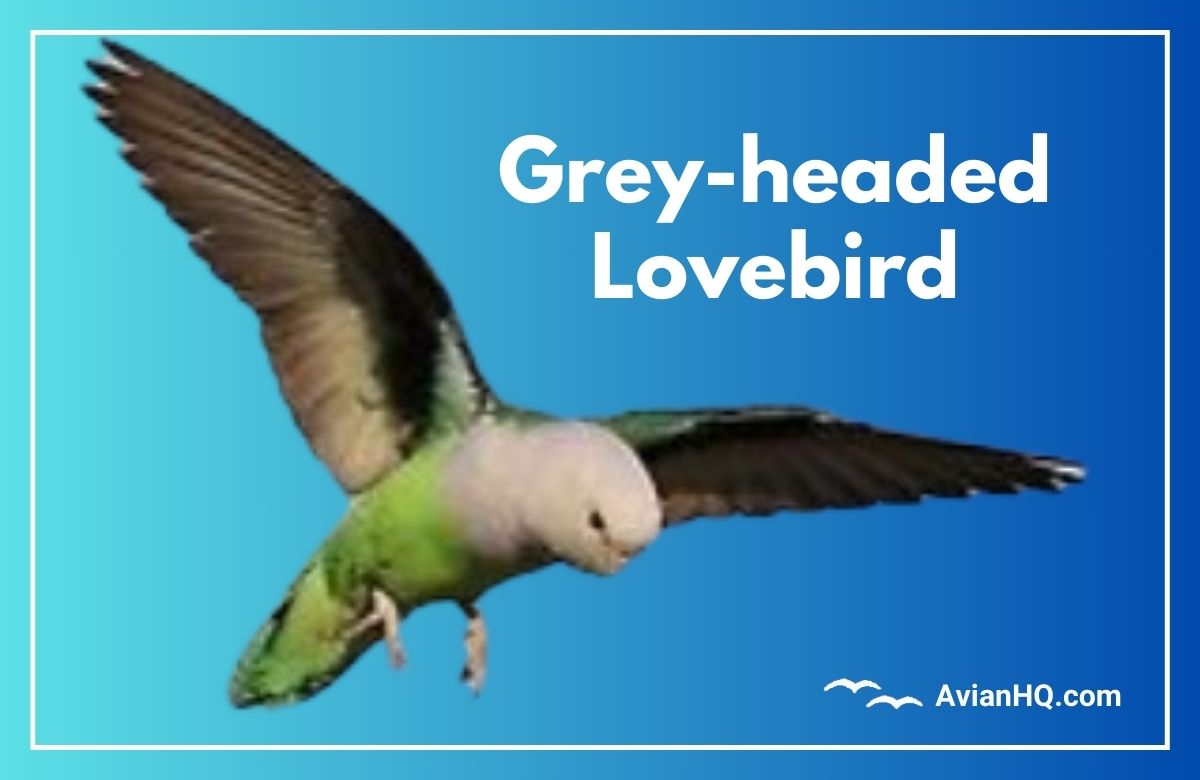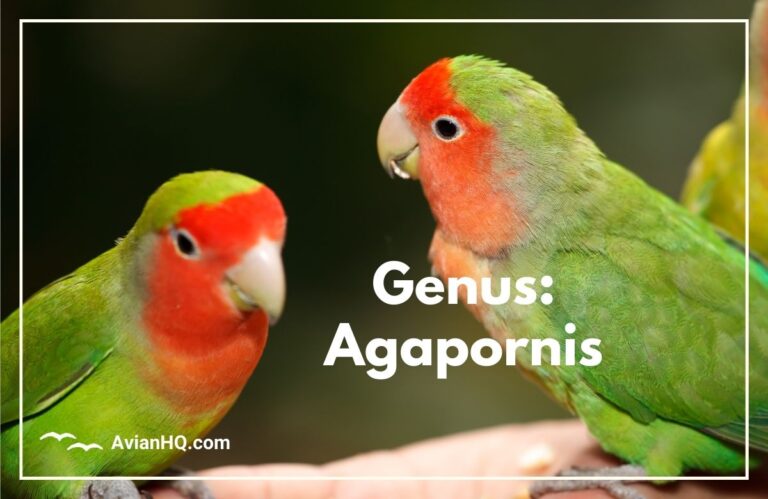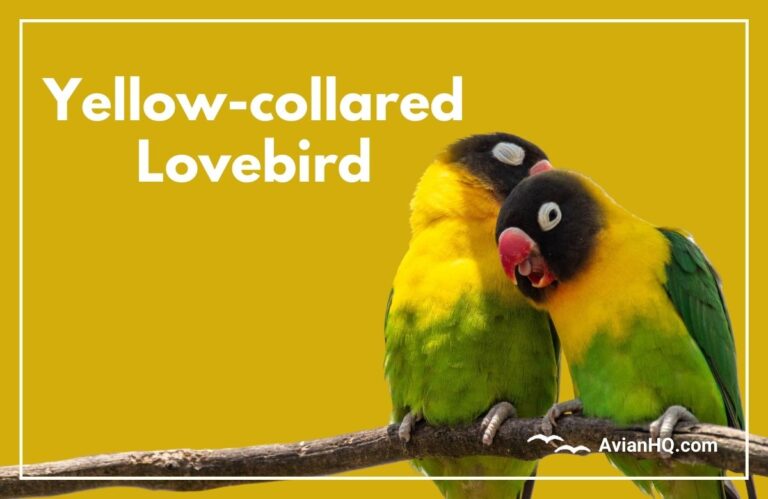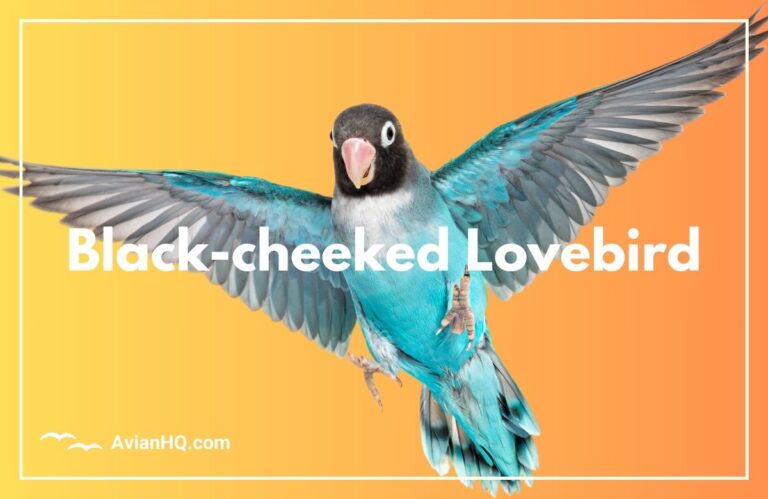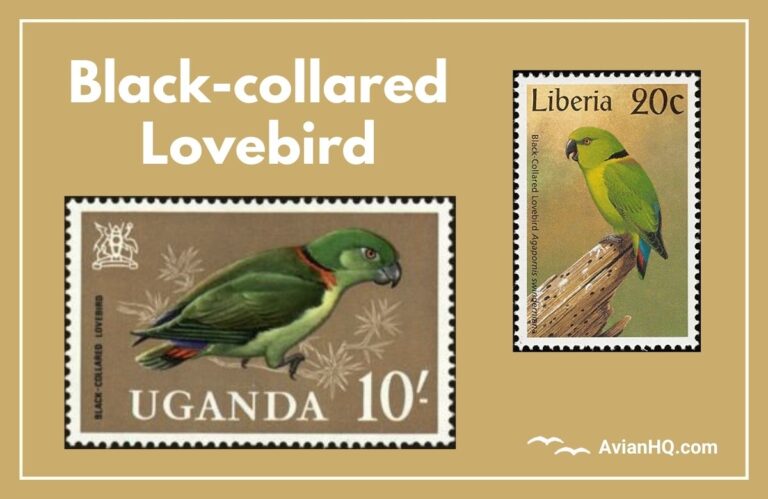Grey-headed Lovebird (Agapornis canus)
As you scan the cages at your local pet store, your eye catches a flash of grey and green. Perched inside is a bird no bigger than your hand, with a striking pale grey head and bright green body. You’ve discovered the rare and beautiful Grey-headed Lovebird, also known as the Madagascar Lovebird.
This petite parrot stands out with its unique coloration. While many lovebirds display vibrant hues of green, yellow, orange and blue, the Grey-headed Lovebird offers something different. Only the male dons the distinctive smoky grey plumage on the head, neck and chest that gives this species its common name.
Lovebirds in general make charming companion birds. But what sets this species apart? Why is the Grey-headed Lovebird seldom seen in captivity compared to the iconic Peach-faced Lovebird?
As you read on, you’ll uncover facts about the natural history, appearance, behavior and conservation status of Agapornis canus. You’ll learn what makes this species challenging for even experienced bird keepers to maintain. And you’ll discover why persistent efforts to conserve the Grey-headed Lovebird are vital for preserving avian biodiversity.
History and Taxonomy
The first known scientific description of the Grey-headed Lovebird was made in 1760 by French zoologist Mathurin Jacques Brisson. He documented a specimen collected on the island of Madagascar and used the name “La petite perruche de Madagascar”, meaning “the small parrot of Madagascar”.
It would be another 28 years until the species received its modern binomial name. In 1788, German naturalist Johann Friedrich Gmelin classified all parrots into the genus Psittacus and gave the Grey-headed Lovebird the name Psittacus canus. This name placed the bird alongside all other known parrot species at the time.
In 1836, English naturalist Prideaux John Selby introduced the new genus Agapornis for the lovebird group. The name combines the Greek words agape meaning “love” and ornis meaning “bird”. And there the Grey-headed Lovebird genus and species names remain today.
Within the species, two subspecies are recognized based on geographic separation and minor plumage differences:
- A. c. canus – Occurs across most of Madagascar except for the southern regions. Plumage of the male has a lighter grey head.
- A. c. ablectaneus – Native only to southwest Madagascar. The male has a darker, more purple-grey colored head.
The division of Agapornis canus into subspecies is not universally accepted. But DNA studies have confirmed the southern Madagascar population is genetically unique and may even constitute a separate species. Ongoing analysis aims to clarify the taxonomic status of the different populations.
Physical Appearance
The Grey-headed Lovebird lives up to its name with the adult male’s distinctive pale gray head, neck, and upper chest. This area contrasts sharply with the vibrant green hue covering the rest of its body. Females and juveniles lack the grey coloring and sport all over green plumage.
These petite parrots measure just 5 inches (13 cm) long from head to tail. Despite their tiny stature, the Grey-headed Lovebird’s wingspan can reach up to 8 inches (20 cm) wide when spread in flight. Their slender build allows them to zip through the air faster than their plump cousins, the Peach-faced Lovebirds.
Males tip the scales at 1 – 1.25 ounces (30 – 36 grams). Females average slightly less at 0.9 – 1 ounces (25 – 28 grams). Such diminutive size makes them Africa’s smallest lovebird species.
In addition to sex-based color differences, the two subspecies show subtle variations in shade. A. c. canus males display a lighter silvery gray on the head and chest compared to the darker smokey purple-gray of A. c. ablectaneus males. All birds have a pale horn-colored beak, white eye-rings, and dark brown irises. Legs and feet range from light to dark gray.
Juvenile males start life with a greenish wash over the head and a yellow beak with black base. As they mature, their adult colors gradually emerge. By one year of age, males achieve their distinctive phenotype. Females cannot be reliably sexed based on appearance alone.
The species lacks any major striking color patches seen in other lovebird species. But its singular head pattern still renders Agapornis canus one of the most visually distinctive – and beautiful – of the genus.
Habitat and Distribution
The Grey-headed Lovebird calls the island nation of Madagascar its native and only home in the wild. Its geographic range extends across most of the island, absent only from extreme northern regions and the drier southwest.
This species thrives across a variety of semi-arid habitats. It frequents open woodlands, palm savannas, scrublands, and areas of human disturbance. Flocks forage along forest edges and grassy areas like rice paddies. Their flexible habitat preferences allow the birds to occupy elevations from sea level up to 4,900 feet (1,500 m).
A small introduced population became established on the islands of Comoros, Seychelles, Rodrigues and Réunion off Africa’s east coast. But only the Comoros population persists today. Unsuccessful introduction attempts also occurred on the African mainland.
The Grey-headed Lovebird once inhabited the Seychelles until disappearing sometime after 1981. Loss of this non-native population represented an early warning of the species’ vulnerability even in suitable habitat. Ongoing conservation efforts now focus on preserving Madagascar’s remaining wild flocks.
Diet and Feeding
The small size of the Grey-headed Lovebird limits the food resources it can utilize. But what they lack in stature, they make up for in adaptability. Their generalist diet allows exploitation of a wide variety of native seeds and agricultural crops.
In the wild, this species feeds predominantly on grass seeds. Flocks forage by scratching at the soil surface and stripping fresh green seed heads straight from the stalks. Two grass species – rice and elephant grass – feature prominently in their menu.
Rice holds special significance as a favorite food whenever the birds encounter it. The sparrowsized lovebirds descend en masse onto ripening rice fields. They voraciously devour the Nutrient-rich grains right off the plants as the crop nears harvest.
In addition to grasses, the Grey-headed Lovebird supplements its diet with other native vegetation. Fruits and berries provide important nutrition when available in Madagascar’s dry forests. The birds sometimes feed on planted crops like corn in agricultural areas.
Small rounded grit helps grind up food in their muscular gizzard. Water is obtained from morning dew, plant moisture, rain pools, and other natural sources. No information exists on how frequently they need to drink under captive conditions.
Unlike larger parrot species, Grey-headed Lovebirds employ a ground-feeding strategy for finding food. Their terrestrial foraging limits competition with Madagascar’s all-vegetarian vangas in the treetop canopy. It also renders them extremely vulnerable to predation when distracted while eating.
Breeding and Reproduction
In the wilds of Madagascar, the onset of the rainy season in November triggers breeding activity in Grey-headed Lovebird flocks. Their preference for nesting in tree cavities limits site availability and constrains reproductive capacity.
Competition among other secondary cavity nesters like starlings and weavers causes these lovebirds to lose out on prime real estate. Suitable nest holes must provide insulation while keeping the cavity dimensions under 7 inches (18 cm) wide.
Once claiming a nest, pairs build a structure of chewed leaves, grass, and bark fragments. The female alone incubates a clutch of 5-7 white eggs for 22-23 days. Hatchlings fledge at 6 weeks old, but continue relying on parental care for an additional two weeks.
These natural history observations provide approximations for captive breeding efforts. But consistently reproducing multiple generations remains elusive even for experienced aviculturalists.
In fact, the Grey-headed Lovebird is considered one of the most challenging lovebirds to breed in captivity. Reasons for their stubborn reproductive reluctance likely involve complex environmental and social factors not yet understood.
Unlocking the secrets behind better captive reproduction could save this species from extinction if their Madagascar habitat degrades beyond recovery. For now, wild flock stability keeps the population sustained – but perpetually at risk if circumstances shift.
Behavior and Ecology
The Grey-headed Lovebird exhibits highly social behaviors as part of its adaptation to life in Madagascar’s arid landscapes. Flocks may gather over 100 individuals when ample food becomes available. But more commonly, foraging groups consist of 15-30 birds that fly and roost together.
At night, the entire flock retires to a traditional roosting site. Favorite sleeping trees stand solitary above the surrounding vegetation. Settling onto horizontal branches, each bird fluffs its feathers against the cold night air. Chattering contact calls permeate the darkness until the group finally dozes off.
This communal roosting behavior concentrates numbers as an anti-predator strategy. During the day, smaller foraging flocks break off to search for seed patches on the ground. Constant vigilance for danger cannot fully protect them from the island’s native predators.
Several key aspects of their behavioral ecology remain unknown to science. The significance of their mixed species flocks with other small bird species is unresolved. Long term monogamous pair bonding may occur, but requires verification. And no population density estimates exist to gauge habitat carrying capacities.
In captivity, the lovebird’s wild instincts manifest in shy and delicate temperaments. They refuse human handling and easily panic when stressed. Providing for their complex social, reproductive, and psychological welfare poses challenges for the most experienced aviculturalists.
Conservation Status
The International Union for Conservation of Nature (IUCN) currently categorizes the Grey-headed Lovebird as Least Concern on their Red List of Threatened Species. But several worrying factors belie this optimistic assessment.
Firstly, no robust population estimates exist for the total number of Grey-headed Lovebirds left in the wild. Documented trade volume gives the best available clues. Between 1981-2005, export data tallied over 107,829 birds trapped for the global market – an alarming figure for such a small species.
Secondly, habitat degradation poses an emerging threat across Madagascar. Deforestation and agricultural expansion may hamper the ability of Grey-headed Lovebird populations to shift their range in response to environmental changes.
Finally, competition from invasive bird species presents an underappreciated threat. Exotic mynas and weavers outcompete native species for nest sites and food resources. Reduced survival of fledgling Grey-headed Lovebirds could slowly depress recruitment.
In response to these concerns, the species was recently listed under Appendix II of the Convention on International Trade in Endangered Species (CITES). Appendix II status bars wild capture for commercial trade outside Madagascar. Only captive bred birds can be legally exported to the pet industry.
Stabilizing Grey-headed Lovebird populations ultimately relies upon sound environmental policies governing Madagascar’s precious remnant forests. In the meantime, ethical captive breeding programs buy critical insurance against irrecoverable losses for Agapornis canus.
Cultural Significance
The island nation of Madagascar boasts rich cultural traditions linked inseparably with its unique wildlife. Yet amid this celebrated biodiversity, the Grey-headed Lovebird occupies relatively little prominence compared to the island’s charismatic lemurs, chameleons, and baobab trees.
One explanation resides in the lovebird’s restricted habitat preferences. Unlike widely admired rainforest fauna, the semi-arid spiny forest biome harboring Grey-headed Lovebirds goes largely overlooked. Locals similarly disregard the tiny parrots flitting through roadside grasslands and rural villages.
Another reason lies in the lovebird’s undistinguished repertoire of vocalizations. Peoples native to Madagascar traditionally keep caged pet parrots renowned for their ability to mimic human songs and speech. Talking lovebirds fail to showcase such talents.
Nonetheless, Grey-headed Lovebirds occasionally appear as pets in Malagasy households. Their lifetime pair bonds and quiet affectionate behaviors likely attracted early collectors of these companions just as aviculturalists prize them today.
Further integration of local values and traditional ethics into Madagascar’s shifting conservation policies offer hope. If habitat loss stems, culturally ingrained biophilia towards the island’s unique species like Agapornis canus may continue sustaining small wild populations into the future.
Conclusion
The exquisite Grey-headed Lovebird has captivated aviculturists since its discovery over 250 years ago. Yet much about Agapornis canus biology and behavior still confounds experts. Solving the mysteries around their challenging captive reproduction could prove critical to safeguarding the wild population numbering just in the tens of thousands.
As one of the smallest parrots on Earth, this species weighs little more than an ounce and fits within the palm of your hand. But protecting their niche on Madagascar carries significance outweighing their petite frames. Preserving the Grey-headed Lovebird ensures vital ecosystem stability and honors the island’s treasured biodiversity.
Beyond conservation value, many feel an emotional connection towards safeguarding this charming bird’s future in the face of so many threats. Habitat loss, climate change, invasive species impacts, and the pet trade all endanger the Grey-headed Lovebird to some degree. Time will tell whether dedicated environmental policies and ethical captive breeding efforts can pull this species back from the brink.
If your travels ever take you to Madagascar, watch the grassy fields near dawn or dusk. There you may glimpse a flock of tiny gray-headed parrots fluttering amongst the slender stalks. Consider yourself privileged to enjoy the beauty of Agapornis canus flying wild and free – while such joys remain possible.

